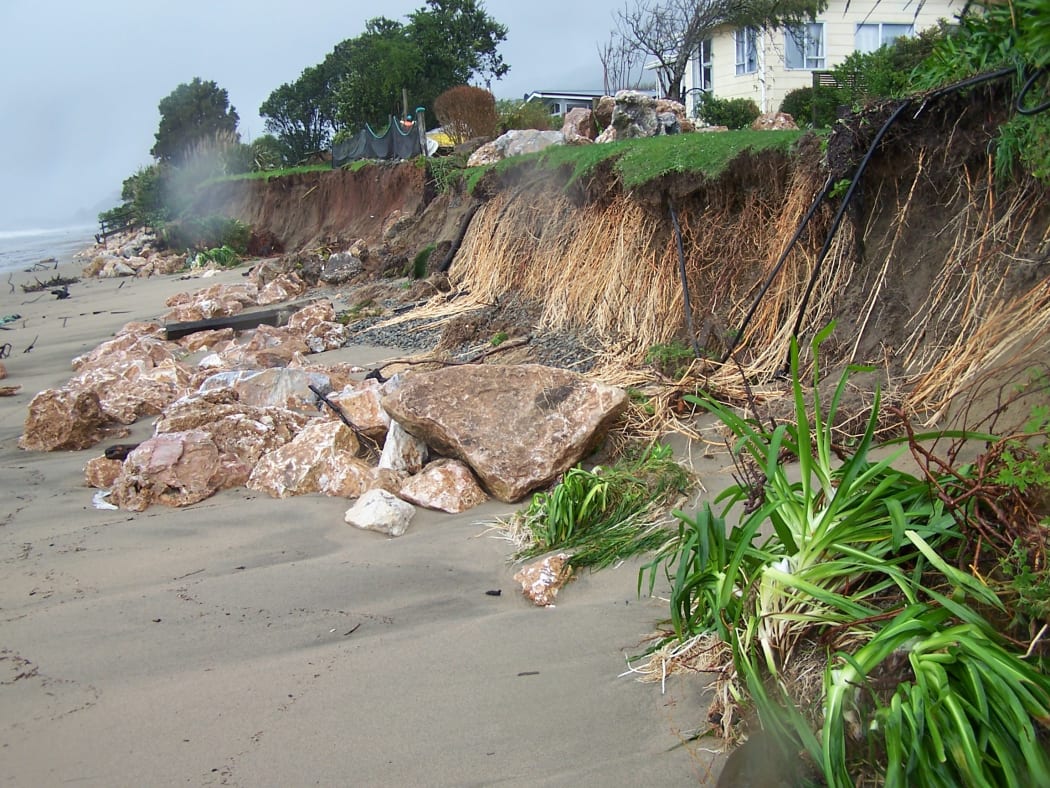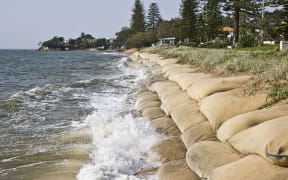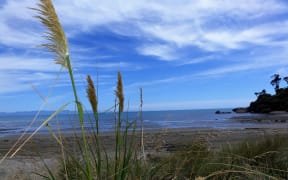Plans for a seawall up to 350 metres long in western Golden Bay are back on the table.

Coastal erosion at Pakawau. Photo: RNZ / Supplied
Property owners in Pakawau, north of Collingwood and on the inside of Farewell Spit, want the wall to protect their homes and land from rapidly increasing coastal erosion.
The area has been battered in recent years by what locals say is increasingly severe weather funnelling through Cook Strait to the south-east of Golden Bay, and wrapping around the top of the Marlborough Sounds.
Engineering firm OCEL Consultants NZ has been studying the area, including research back to 1950, said that while the area was typically benign, the foreshore retreat would continue due to changed environmental factors.
The firm said in a report that erosion was expected to accelerate due to sea level rise guidelines proposed by the Ministry for the Environment coupled with suggested increases in the frequency and severity of storms.
"Golden Bay is dominated by calm conditions virtually all year round, interspersed with periods of intense wave activity," the report said.
A resident since 1957, Laurie Jarrett, said he has watched the shoreline retreat since then.
"The shoreline continues to go back, and back and back."
Mr Jarrett said a subdivision created there in 1959 had about 30 metres of sand dunes on the seaward side of the houses.
He said sand dunes built up in the past, and attempts so far to mitigate the effects of erosion had "dissolved like disprin" by the forces of more El Niño weather patterns of late.
"It's gone from 20 to 30 metres of dunes - to now being within two metres of some of the sections."
The consultants report said historical aerial photographs and recent site surveys helped gain a clear understanding of the coastal processes in the area.
It described the area of Golden Bay as a "shallow slope of broad flat beach" with a large tidal range and relatively benign nearshore wave conditions. These features provided a degree of natural protection to the coastline, but it was unable to withstand "wave attack" generated from storm events.
The report said that along with the lack of ability for the dunes to naturally re-establish themselves, continued retreat of the coastline along the proposed seawall site had happened.
Mr Jarrett is spokesman for the local residents association which was seeking resource consent for the 345-metre wall, but had to put the process on hold late last year.
He said it was turning into an uphill battle when the association could not find a consultant planner willing to take on the job. It sought a halt on the consent application process when it became clear it was unlikely to get a decent outcome.
"It meant hiring a consultant planner to represent us at a hearing and we could not find one prepared to take our job."
Mr Jarrett said they had now found an independent Queenstown based planner, and a hearing has been scheduled for March this year.
The proposed wall would be a continuation of an existing wall at the Pakawau camping ground. It was estimated to cost up to $400,000 to build, while the Tasman District Council has worn the cost so far of processing consents, Mr Jarrett said.
He said the construction cost would be shared among 18 land owners at Pakawau.
The project needed several consents, including one that allowed for disturbance of the coastal marine area.





